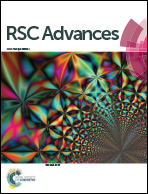PO43− doped Li4Ti5O12 hollow microspheres as an anode material for lithium-ion batteries†
Abstract
Li4Ti5O12 has been considered as one of the most promising alternative anode materials for high power lithium ion batteries due to its excellent cycle life and good safety. In particular, the superior high-rate capability of Li4Ti5O12 is indispensable for practical application in high power batteries. Herein, in order to enhance the high-rate capability of Li4Ti5O12, Li4Ti5O12 hollow microspheres are successfully prepared via a template method and solid-state reaction by annealing in an argon atmosphere. Importantly, doping with larger PO43− anions is introduced to improve the kinetics of the Li4Ti5O12 anode materials. The microstructure and morphology of the as-prepared Li4Ti5O12(PO4)x (x = 0, 0.01, 0.02, and 0.03) hollow microspheres are characterized by X-ray diffraction (XRD), transmission electron microscopy (TEM), scanning electron microscopy (SEM) and Fourier transform infrared (FTIR) spectroscopy. It is demonstrated from the electrochemical measurements that the as-prepared Li4Ti5O12(PO4)0.02 sample manifests optimized electrochemical performance, including better cycle stability and outstanding high-rate performance during cycling. In particular, Li4Ti5O12(PO4)0.02 presents the discharge capacity of 117.6 mA h g−1 at 50C rate, obviously larger than that (70.5 mA h g−1) of the pristine Li4Ti5O12 due to the improvement of the kinetics, including charge-transfer resistance and lithium ion diffusion impedance. As a consequence, Li4Ti5O12(PO4)0.02 is considered as a promising anode material with superior high-rate performance for lithium ion batteries.


 Please wait while we load your content...
Please wait while we load your content...